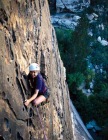

Climbing

Quick Link - Good Points - Bad Points - Tips - Costs - Resources
Introduction
Climbing is another simple yet spine-tingly exciting sport. A simple concept of just you, a rope, and a small obstacle to climb, such as a cliff face!
Why would I want to do that?
The many phrases relating to feelings of success such as "on top of the world" and "on a high" can be directly applied to climbing. Because, when you take on your rock face obstacle and accomplish your goal by reaching the top, you feel a natural sense of achievement and you really can understand the meaning of "on top of the world".

Climbing can be done indoors on artificial climbing walls, But for some, it is the prospect of scaling mother-natures beautiful scenery that is the attraction. For others it might be a spiderman-like desire to hang of walls!
Risk
There is the ultimate option of climbing without the security of ropes or artificial aid - free soloing. In this more precarious method of climbing, the risks are considerably higher (and the associated rush, higher also) which is why only experienced climbers attempt free soloing, and it is not advised anyone else try it straight off.
Of course there is a wide spectrum of risk and you choose the level of risk you want to expose yourself to. For instance, lower risk climbing would be bouldering, where you climb up rocks of a height you can jump from safely, plus you have "spotters" who assist you with your landing if you fall.
How do you get started?

A first step would be to check out your nearest climbing centre or club listed with the BMC (British Mountaineering Council). Within these clubs, you will find competent climbers to train and develop your climbing techniques.
As a side note, climbing is often part of multi-activity action weekends away (perhaps corporate events), so you can get a taster whilst trying other activities as well.
What Equipment Do I Need?
The most important part of any climber's wardrobe is their tight fitting shoes, worn without socks.
The gadgets that make up safe climbing kit include:
Carabiners - small metal lockable hooks used to attach equipment together.
Harness - Your safety nappy, it supports your body and is attached to a rope; great to stop you falling. (However, not designed to deal with scary poopy moments!)
Belay - your rope hooks through this metal device to give you some control in descent.
Rope - quite pricey, about the same as the climbing shoes. Various lengths, dependent on how far you want to climb.
Other stuff you may want to buy are: chalk (for better grip) and chalk bag, and a helmet to protect your nod from stray rocks. Not forgetting clothes designed for climbing.
Generally
Climbers are a sociable bunch, willing to share experience and knowledge. You don't think about that when you are climbing though, in fact most of your energy goes in to supporting your body from limited hand & foot-holds and mentally planning the best route upwards.
Anyone can try climbing, and although hanging off the face of a cliff initially sounds dangerous, the technology in ropes, and equipment is unsurpassed in quality and reliability. Resulting in a sport which provides challenges, thrills and highs whilst still being a relatively safe sport.

Summary of Climbing
Good points
Feeling a natural high of accomplishment when conquering big climbs.
Varying levels of risk for different facets of climbing.
Healthy, natural, environmentally friendly sport, with many opportunities to try it.
Bad points
Possibility of death / serious injury in the more dangerous forms of climbing.
Limited to people who are light or strong or both.
Slow to watch, (but action-packed to do)
Take a lesson at a club first off, to gain the basics and learn under safe conditions.
Hire out gear initially, wait until you know more about the climbing equipment that suits you before you buy your own.
Look in to climbing holidays, there are some very exotic places which provide superb climbing experiences.
Specialist climbing shoes range in price from �65 to �130
Climbing lessons in clubs are reasonably priced starting from �20 upwards, and all equipment can be hired, for nominal sums around �10 complete.
If purchasing your own equipment, go for good value packages which often include carabiner, harness, belay device, chalk bag and chalk.
(Click to open in new window)
The BMC - The British Mountaineering Council is the official body representing climbing and related activities, site includes a database of clubs.
Planet Fear - Big site with UK writers, including training, climbing holidays, news, a shop and more. Look for the "getting started" article, it is very useful.
Climbing Magazine - US climbing magazine, interesting how-to sections for the practicing climber.
UK Climbing - Has climbing forums, climbing news and lists of cliff sites and indoor climbing walls in the UK.
All Rights Reserved
Tips
Costs
Climbing Resources
 Adrenaline-Sports.net users are looking for reputable businesses to purchase from. Your business can be featured right here!
Adrenaline-Sports.net users are looking for reputable businesses to purchase from. Your business can be featured right here!
 Cotswold Outdoor - Massive online Shop with national presence, catering for all climbing, walking and camping activities.
Cotswold Outdoor - Massive online Shop with national presence, catering for all climbing, walking and camping activities.
 Cordee - UK shop specialising in maps, climbing and hiking guides.
Cordee - UK shop specialising in maps, climbing and hiking guides.
Copyright Adrenaline-Sports.net © 2000 - 2004






